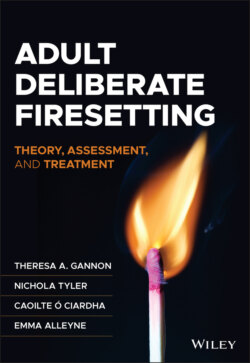Читать книгу Adult Deliberate Firesetting - Theresa A. Gannon - Страница 24
Characteristics of Subgroups of Adults Who Set Fires
ОглавлениеThe research on characteristics of adults who set fires is dominated by studies that imply a certain homogeneity in the life events and the psychological or psychopathological vulnerabilities of these individuals. In other words, research often pits a group of individuals who have set deliberate fires against a group of individuals who have not. This approach risks oversimplifying a nuanced and complex phenomenon. Both theory (e.g., Gannon et al., 2012) and research on motives or typologies in firesetting (e.g., Lewis & Yarnell, 1951) paint the picture of a much more heterogeneous population following varied offence pathways (see also Barnoux et al., 2015; Tyler & Gannon, 2017). Therefore, it is important to think beyond the very general characteristics of people who set fires and instead consider finer-grained distinctions within this population. We have already examined the interaction of gender and firesetting status in the earlier sections. However, researchers have also investigated the characteristics of specific subsets of individuals who set fires, including those who engage in repeated firesetting or high-consequence firesetting, as well as those whose firesetting may belong to specific typologies or trajectories.
The rates of recorded firesetting recidivism are relatively low (Ducat et al., 2015; Rice & Harris, 1996; Thomson et al., 2018). Sambrooks et al. (2021) meta analysed studies looking at reoffending by untreated adults or children with a history of firesetting. They again found relatively low rates of reoffending (8%–10%) when considering reoffending as convictions (or arrests or charges in one study) for “arson”. Using a broader definition of firesetting, however, the reoffending rate was higher (20%). Doley et al. (2011) summarised a limited literature on the characteristics of individuals who set repeated fires. They also identified a number of promising target areas for future research on recidivism in this population. The following decade has seen publication of some robust examinations of repeat firesetting, though there remains a lot of potential for further research in this area. Synthesising this literature, the strongest evidence of characteristics of repeat firesetting includes having fire interest (Dickens et al., 2009; Tyler et al., 2015), more past firesetting incidents (Ducat et al., 2015; Rice & Harris, 1996), young age at first firesetting (Dickens et al., 2009; Rice & Harris, 1996), being criminally versatile (Dickens et al., 2009; Ducat et al., 2015), personality disorder (Dickens et al., 2009; Thomson et al., 2018; Wyatt et al., 2019), intellectual disability (Bell et al., 2018), and childhood adversity (Bell et al., 2018; Dickens et al., 2009).
Dickens and colleagues (2009) highlighted the need to parse the dangerousness of firesetting from recidivism. They reported that few of their variables were able to predict the dangerousness of fires and those that did related to the firesetting behaviour itself rather than individual characteristics. However, building on this research Nanayakkara et al. (2020b) examined the characteristics of individuals who engaged in what they termed high-consequence firesetting (i.e., the setting of fires that resulted in fatality or high financial costs). They reported that high-consequence firesetting could be arranged into five types based on the clustering together of demographic, situational, and crime behaviour variables recorded in coroner files. Here, individuals whose firesetting appeared object-focused (e.g., vandalism) were typically younger, had less violence in their offending histories, and had higher rates of repeat firesetting compared with individuals whose firesetting was person-focused who had less repeat firesetting or violence in their pasts but greater symptoms of major mental illness. The nature of the data (i.e., coroners reports) with which Nanayakkara et al. (2020b) developed their typology somewhat limits what can be said about the psychological characteristics of the different groupings of individuals who set fires. However, in interpreting their typology, Nanayakkara and colleagues (2020b) argue that they provide at least partial evidence of four of five hypothetical pathways to adult firesetting proposed within the M-TTAF (Gannon et al., 2012).
Dalhuisen et al. (2017), set out explicitly to assess the trajectories of the M-TTAF using all individuals referred to a single clinic in the Netherlands over a period of over 60 years for pretrial assessment following a suspected firesetting offence. They reported that their participants appeared to cluster into five groupings. Dalhuisen et al. (2017) interpreted their findings as partially supporting the hypothesised M-TTAF trajectories. Perhaps more important for the focus of the current chapter, their findings appear to evidence considerable variability within samples of individuals who have set fires in terms of developmental (history of abuse), psychopathological (psychosis), and psychological (empathy, impulsivity, coping, and social skills) characteristics.
